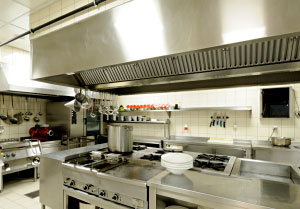Cooking Ventilation Design
A typical cooking ventilation design would consist of exhaust canopy or hood, fan assembly, ductwork and provisions for sufficient supply of make-up air. The overall design must address critical elements of the cooking ventilation system that are related to safety, comfort and efficiency. The exhaust canopies and hoods are considered as lynchpins of the cooking ventilation design and are used to capture the heat, particulates and other air impurities that are generated while cooking your favorite recipe.
The filtration process occurs as the stale air passes through layers of filtering materials. The main types of filters used in cooking ventilation design are the baffle type and mesh type.
Cooking Ventilation Design Basics
There are various cooking ventilation design variations, and you must learn how to find the specific design that meets the requirements of your modern kitchen. These design variations are generally based on the type of cooking equipment as well as the kinds of contaminates that exist in your kitchen. While there is a slew of cooking ventilation design variations, all of these can be classified into 2 main categories:
- Type I cooking ventilation system – This type of cooking ventilation design follow an installation method that is specified by the manufacturer and complies with the requirements of the listing agencies. The overall design takes into consideration the efficient handling and control of grease and other residues and integrates critical components into the cooking ventilation hood.
- Type II cooking ventilation system – This type of cooking ventilation system are specifically designed for the collection of odors and other impurities, except grease and other fat residues. There are 2 sub-categories under this type, and these are the fume/heat ventilation hoods and the condensate ventilation hoods.
Ductwork of Cooking Ventilation System
The exhaust ductwork is an important component of the cooking ventilation design. The overall design must properly address the reduction or elimination of heat and vapors as well as the transfer of stale air from the hood or canopy to the high-performance fan. There are specific safety issues that must be addressed in the overall cooking ventilation design. For instance, the ductworks must have the necessary provisions to prevent accidental combustion.
Thus, non-combustible supports and bracing should be included in the design template. In addition to this, the ducts must be constructed using 18-gauge stainless or 16-gauge steel material to comply with the existing safety standards. The overall design must also take into account the kind of material that is going to be used for the ceiling and hood enclosure, and it is a must that you use fire-rated materials for the enclosures.
Exhausts Fans of Cooking Ventilation Systems
Heat and stale air are moved and expelled out of the home with the use of exhaust fans. It is imperative that the components of the exhaust fans can be easily accessed or must have convenient access panels for inspection and maintenance. The overall cooking ventilation design must have provisions for the containment and draining of grease and other fat residues.

